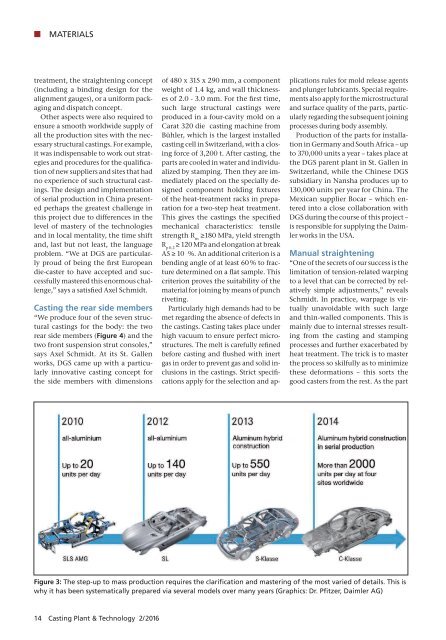CPT International 02/2016
The leading technical journal for the global foundry industry – Das führende Fachmagazin für die weltweite Gießerei-Industrie
The leading technical journal for the
global foundry industry – Das führende Fachmagazin für die
weltweite Gießerei-Industrie
Create successful ePaper yourself
Turn your PDF publications into a flip-book with our unique Google optimized e-Paper software.
K MATERIALS<br />
treatment, the straightening concept<br />
(including a binding design for the<br />
alignment gauges), or a uniform packaging<br />
and dispatch concept.<br />
Other aspects were also required to<br />
ensure a smooth worldwide supply of<br />
all the production sites with the necessary<br />
structural castings. For example,<br />
it was indispensable to work out strategies<br />
and procedures for the qualification<br />
of new suppliers and sites that had<br />
no experience of such structural castings.<br />
The design and implementation<br />
of serial production in China presented<br />
perhaps the greatest challenge in<br />
this project due to differences in the<br />
level of mastery of the technologies<br />
and in local mentality, the time shift<br />
and, last but not least, the language<br />
problem. “We at DGS are particularly<br />
proud of being the first European<br />
die-caster to have accepted and successfully<br />
mastered this enormous challenge,”<br />
says a satisfied Axel Schmidt.<br />
Casting the rear side members<br />
“We produce four of the seven structural<br />
castings for the body: the two<br />
rear side members (Figure 4) and the<br />
two front suspension strut consoles,”<br />
says Axel Schmidt. At its St. Gallen<br />
works, DGS came up with a particularly<br />
innovative casting concept for<br />
the side members with dimensions<br />
of 480 x 315 x 290 mm, a component<br />
weight of 1.4 kg, and wall thicknesses<br />
of 2.0 - 3.0 mm. For the first time,<br />
such large structural castings were<br />
produced in a four-cavity mold on a<br />
Carat 320 die casting machine from<br />
Bühler, which is the largest installed<br />
casting cell in Switzerland, with a closing<br />
force of 3,200 t. After casting, the<br />
parts are cooled in water and individualized<br />
by stamping. Then they are immediately<br />
placed on the specially designed<br />
component holding fixtures<br />
of the heat-treatment racks in preparation<br />
for a two-step heat treatment.<br />
This gives the castings the specified<br />
mechanical characteristics: tensile<br />
strength R m<br />
≥180 MPa, yield strength<br />
R p 0.2<br />
≥ 120 MPa and elongation at break<br />
A5 ≥ 10 %. An additional criterion is a<br />
bending angle of at least 60 % to fracture<br />
determined on a flat sample. This<br />
criterion proves the suitability of the<br />
material for joining by means of punch<br />
riveting.<br />
Particularly high demands had to be<br />
met regarding the absence of defects in<br />
the castings. Casting takes place under<br />
high vacuum to ensure perfect microstructures.<br />
The melt is carefully refined<br />
before casting and flushed with inert<br />
gas in order to prevent gas and solid inclusions<br />
in the castings. Strict specifications<br />
apply for the selection and applications<br />
rules for mold release agents<br />
and plunger lubricants. Special requirements<br />
also apply for the microstructural<br />
and surface quality of the parts, particularly<br />
regarding the subsequent joining<br />
processes during body assembly.<br />
Production of the parts for installation<br />
in Germany and South Africa – up<br />
to 370,000 units a year – takes place at<br />
the DGS parent plant in St. Gallen in<br />
Switzerland, while the Chinese DGS<br />
subsidiary in Nansha produces up to<br />
130,000 units per year for China. The<br />
Mexican supplier Bocar – which entered<br />
into a close collaboration with<br />
DGS during the course of this project –<br />
is responsible for supplying the Daimler<br />
works in the USA.<br />
Manual straightening<br />
“One of the secrets of our success is the<br />
limitation of tension-related warping<br />
to a level that can be corrected by relatively<br />
simple adjustments,” reveals<br />
Schmidt. In practice, warpage is virtually<br />
unavoidable with such large<br />
and thin-walled components. This is<br />
mainly due to internal stresses resulting<br />
from the casting and stamping<br />
processes and further exacerbated by<br />
heat treatment. The trick is to master<br />
the process so skilfully as to minimize<br />
these deformations – this sorts the<br />
good casters from the rest. As the part<br />
Figure 3: The step-up to mass production requires the clarification and mastering of the most varied of details. This is<br />
why it has been systematically prepared via several models over many years (Graphics: Dr. Pfitzer, Daimler AG)<br />
14 Casting Plant & Technology 2/<strong>2016</strong>


















